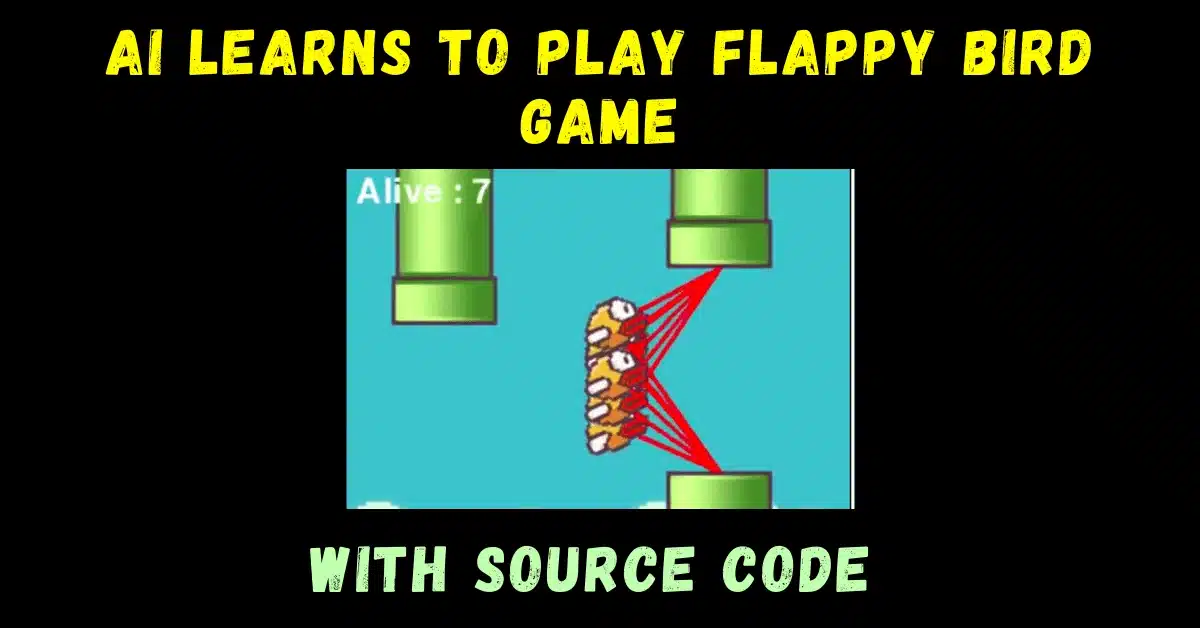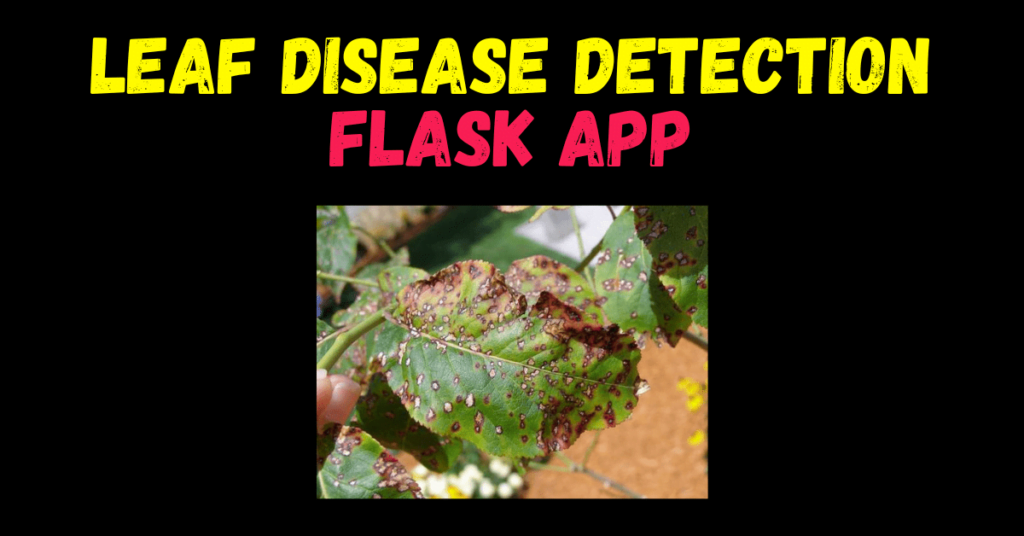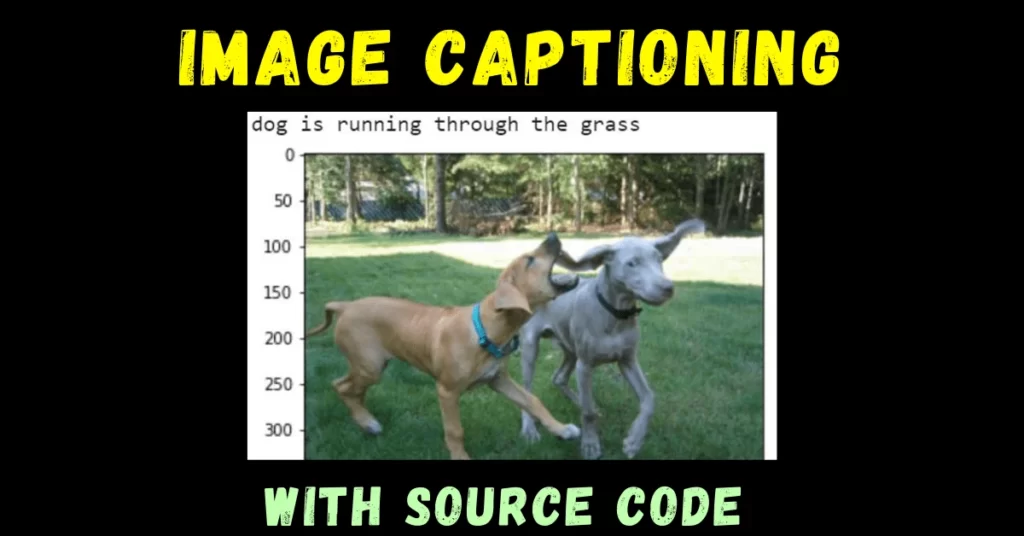So, in today’s blog, we will implement the Flappy Bird Game which will be played by an AI. We will achieve this by using NEAT which stands for NeuroEvolution of Augmenting Topologies.
One of the major fantasies of every machine learning engineer is to make a game that can learn to play on itself. In today’s blog, we will see that how we can do that. So without wasting any time, Let’s do it…
We will mainly need the following 2 libraries to implement this:
- pygame
- neat-python
Code for the Flappy Bird Game…
import pygame
import neat
import os
import random
pygame.font.init() # some initialization to use font in pygame
WIN_HEIGHT = 800
WIN_WIDTH = 500
DRAW_LINES = True
GEN = 0 # declaring generation variable
pygame.display.set_caption("Flappy Bird")
# importing the images of birds, pipes, background and base
BIRD_IMGS = [pygame.transform.scale2x(pygame.image.load('imgs\\bird1.png')),
pygame.transform.scale2x(pygame.image.load('imgs\\bird2.png')),
pygame.transform.scale2x(pygame.image.load('imgs\\bird3.png'))]
BASE_IMG = pygame.transform.scale2x(pygame.image.load('imgs\\base.png'))
BG_IMG = pygame.transform.scale2x(pygame.image.load('imgs\\bg1.png'))
PIPE_IMG = pygame.transform.scale2x(pygame.image.load('imgs\\pipe.png'))
# declaring font
STAT_FONT = pygame.font.SysFont('comicsans', 50)
# CLASS BIRD
class Bird:
ROTATION_VEL = 20
MAX_ROTATION = 25
ANIMATION_TIME = 5
IMGS = BIRD_IMGS
def __init__(self, x, y): # constructor for class bird
self.x = x
self.y = y
self.height = self.y
self.frame_count = 0
self.tilt = 0
self.vel = 0
self.img_number = 0 # image in which the bird's wings are upwards
self.img = self.IMGS[0] # image in which the bird's wings are upwards
def jump(self):
self.vel = -10.5 # negative velocity refers to jump upwards
self.frame_count = 0 # reset the frames
self.height = self.y # reset the height
def move(self):
self.frame_count += 1 # update the frames when the bird moves
# d > 0 means downwards and d<0 means upwards and same for velocity also
# and also bird is just moving in y direction and not in x direction
d = self.vel * self.frame_count + 1.5 * self.frame_count ** 2 # frame count also works as time
if d >= 16: # if the bird is falling and it falls more than 16 pixels then stop falling and face straight moving
d = 16
# if d < 0: # just for tuning so that upward movement is seen clear
# d -= 2
self.y = self.y + d
if d < 0 or self.y < self.height + 50: # (d<0) this is the case when when bird is going upward
if self.tilt < self.MAX_ROTATION: # so making a tilt angle of max rotation
self.tilt = self.MAX_ROTATION
else:
if self.tilt > -90: # if the tilt is greater than -90 then keep on reducing it till it reaches -90 to show
self.tilt -= self.ROTATION_VEL # the arc like falling
def draw(self, win):
self.img_number += 1
# below work is done to show the flapping of the bird
# animation time is that for how much time bird should be in one image state
if self.img_number < self.ANIMATION_TIME:
self.img = self.IMGS[0]
elif self.img_number < self.ANIMATION_TIME * 2:
self.img = self.IMGS[1]
elif self.img_number < self.ANIMATION_TIME * 3:
self.img = self.IMGS[2]
elif self.img_number < self.ANIMATION_TIME * 4:
self.img = self.IMGS[1]
elif self.img_number < self.ANIMATION_TIME * 4 + 1:
self.img = self.IMGS[0]
self.img_number = 0
if self.tilt < -80: # when the bird is nose diving it should not flap its wings
self.img = self.IMGS[1]
self.img_number = self.ANIMATION_TIME * 2 # reset the image number so that next image should be IMG[2]
rotated_image = pygame.transform.rotate(self.img, self.tilt) # just rotating the image around its center
new_rect = rotated_image.get_rect(center=self.img.get_rect(topleft=(self.x, self.y)).center)
win.blit(rotated_image, new_rect)
def get_mask(self): # getting the mask of the bird means the contour of bird to check its collision with any pipe
return pygame.mask.from_surface(self.img)
class Pipe:
GAP = 200
VEL = 5
def __init__(self, x):
self.x = x
self.height = 0 # for random purpose
self.top = 0 # y coordinates of top pipe
self.bottom = 0 # y coordinates of bottom pipe
self.TOP_PIPE = pygame.transform.flip(PIPE_IMG, False, True)
self.BOTTOM_PIPE = PIPE_IMG
self.passed = False
self.set_height()
def set_height(self): # randomly setting the heights of both pipes
self.height = random.randrange(50, 450)
self.bottom = self.height + self.GAP
self.top = self.height - self.TOP_PIPE.get_height()
def move(self):
self.x -= self.VEL
def draw(self, win):
win.blit(self.TOP_PIPE, (self.x, self.top))
win.blit(self.BOTTOM_PIPE, (self.x, self.bottom))
def collide(self, bird): # for checking collision of the bird with the pipes
bird_mask = bird.get_mask()
top_pipe_mask = pygame.mask.from_surface(self.TOP_PIPE)
bottom_pipe_mask = pygame.mask.from_surface(self.BOTTOM_PIPE)
top_offset = (self.x - bird.x, self.top - round(bird.y))
bottom_offset = (self.x - bird.x, self.bottom - round(bird.y))
top_overlap = bird_mask.overlap(top_pipe_mask, top_offset)
bottom_overlap = bird_mask.overlap(bottom_pipe_mask, bottom_offset)
if top_overlap or bottom_overlap:
return True
return False
# BASE Class for showing base
class Base:
VEL = 5
IMG = BASE_IMG
WIDTH = BASE_IMG.get_width()
def __init__(self,
y): # base will be shown moving by taking two images of the same base and putting it one after other
self.y = y
self.x1 = 0 # here x1 and x2 are the 2 images where x1 comes first and then x2
self.x2 = self.WIDTH
def move(self):
self.x1 -= self.VEL
self.x2 -= self.VEL
if self.x1 < -self.WIDTH:
self.x1 = self.x2 + self.WIDTH
if self.x2 < -(self.WIDTH):
self.x2 = self.x1 + self.WIDTH
def draw(self, win):
win.blit(self.IMG, (self.x1, self.y))
win.blit(self.IMG, (self.x2, self.y))
# Our main drawing function
def draw_window(win, birds, pipes, base, score, GEN, pipe_ind):
global DRAW_LINES
win.blit(BG_IMG, (0, 0)) # drawing the background
for pipe in pipes: # drawing the pipe or pipes as there can be more than one pipes also in one window
pipe.draw(win)
base.draw(win) # drawing the base
for bird in birds:
# draw lines from bird to pipe
if DRAW_LINES:
try:
pygame.draw.line(win, (255, 0, 0),
(bird.x + bird.img.get_width() / 2, bird.y + bird.img.get_height() / 2),
(pipes[pipe_ind].x + pipes[pipe_ind].TOP_PIPE.get_width() / 2, pipes[pipe_ind].height),
5)
pygame.draw.line(win, (255, 0, 0),
(bird.x + bird.img.get_width() / 2, bird.y + bird.img.get_height() / 2), (
pipes[pipe_ind].x + pipes[pipe_ind].BOTTOM_PIPE.get_width() / 2,
pipes[pipe_ind].bottom), 5)
except:
pass
bird.draw(win)
text = STAT_FONT.render('Score : ' + str(score), 1, (255, 255, 255)) # printing the score on screen
win.blit(text, (WIN_WIDTH - 10 - text.get_width(), 10))
text = STAT_FONT.render('Gen : ' + str(GEN), 1, (255, 255, 255)) # printing the generation on screen
win.blit(text, (10, 10))
text = STAT_FONT.render('Alive : ' + str(len(birds)), 1, (255, 255, 255)) # printing the alive on screen
win.blit(text, (10, 50))
pygame.display.update()
def main(genomes, config):
global GEN
GEN += 1
birds = []
ge = []
neural_networks = []
# everytime new generation comes make new birds and neural networks
for _, g in genomes:
net = neat.nn.FeedForwardNetwork.create(g, config)
neural_networks.append(net)
birds.append(Bird(230, 350))
g.fitness = 0
ge.append(g)
pipes = [Pipe(500)] # list of pipe objects
base_object = Base(630)
win = pygame.display.set_mode((WIN_WIDTH, WIN_HEIGHT))
clock = pygame.time.Clock()
run = True
score = 0
# OUR main running loop
while run:
clock.tick(30) # fps
for event in pygame.event.get():
if event.type == pygame.QUIT: # if the user click on the red cross button then quit the game
run = False
pygame.quit()
quit()
pipe_ind = 0
# this part is done to check in the case when 2 pipes appear on the screen that which is the pipe we are evaluating on
if len(birds) > 0:
if len(pipes) > 1 and birds[0].x > pipes[0].x + pipes[0].TOP_PIPE.get_width():
pipe_ind = 1
else: # if all the birds are dead then exit the loop
break
for x, bird in enumerate(birds): # traversing every bird
bird.move()
ge[x].fitness += 0.1 # incrementing little fitness to keep them moving
# this is the output list which the nn is giving for all the birds whether to jump or not
output = neural_networks[x].activate(
(bird.y, abs(bird.y - pipes[pipe_ind].height), abs(bird.y - pipes[pipe_ind].bottom)))
if output[0] > 0.5:
bird.jump()
for pipe in pipes:
for x, bird in enumerate(birds):
# checking if the bird has hit the ground or if the pipe and bird collide or if the bird has touched te top boundary
if pipe.collide(bird) or (bird.y + bird.img.get_height() >= 630 or bird.y < 0):
ge[x].fitness -= 1 # remove all things of that bird from that bird's position
birds.pop(x)
ge.pop(x)
neural_networks.pop(x)
if not pipe.passed and bird.x > pipe.x: # if the passed is not set to true and bird has passed the pipe then set it to true
pipe.passed = True
for g in ge:
g.fitness += 5 # adding fitness to birds which passed
score += 1
pipes.append(Pipe(500)) # add another pipe
if pipe.x + pipe.TOP_PIPE.get_width() < 0: # if pipe passed the screen remove it
pipes.remove(pipe)
pipe.move()
base_object.move()
draw_window(win, birds, pipes, base_object, score, GEN, pipe_ind)
def run(config_path):
config = neat.config.Config(neat.DefaultGenome, neat.DefaultReproduction,
neat.DefaultSpeciesSet, neat.DefaultStagnation, config_path)
population = neat.Population(config)
population.add_reporter(neat.StdOutReporter(True))
stats = neat.StatisticsReporter()
population.add_reporter(stats)
winner = population.run(main, 50)
print('\nBest genome:\n{!s}'.format(winner))
if __name__ == '__main__':
local_dir = os.path.dirname(__file__)
config_path = os.path.join(local_dir, 'config-feedforward.txt')
run(config_path)
# This was the code for Flappy Bird Game
- Line 1-4 – Importing required libraries for Flappy Bird Game.
- Line 8-11 – Some constants.
- Line 16-21 – Importing the images of birds, pipes, background and base.
- Line 28-95 – Creating class Bird for Flappy Bird Game.
- Line 98-137 – Creating class Pipe for Flappy Bird Game.
- Line 141-163 – Creating class Base for Flappy Bird Game.
- Line 167-200 – Our main window in which our game will be displayed.
- Line 203-276 – Taking all the pieces together and making the game.
- Line 279-288 – This function will run the entire code. This function will also tell us that which generation was the best.
- Line 291-294 – Just calling the run function above and passing the path of config file along with it..





Final Result
Download Source Code for Flappy Bird Game…
Do let me know if there’s any query regarding the Flappy Bird Game by contacting me on email or LinkedIn. You can also comment down below for any queries.
So this is all for this blog folks, thanks for reading it and I hope you are taking something with you after reading this and till the next time ?…
Read my previous post: FIRE AND SMOKE DETECTION USING CNN WITH KERAS
Check out my other machine learning projects, deep learning projects, computer vision projects, NLP projects, Flask projects at machinelearningprojects.net.






